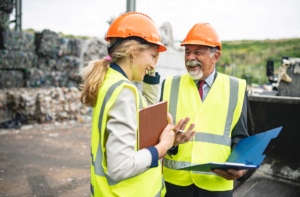Cleanup After the Storm: A Comprehensive Guide to Efficient and Safe Debris Removal
Natural disasters such as storms, hurricanes, and tornadoes can cause significant damage to properties and leave behind a trail of debris. Cleaning up after a storm can be a daunting task, but it is essential to restore normalcy and prevent further damage. In this article, we will discuss the significance and importance of a systematic approach to debris removal, appropriate safety measures, and proper disposal methods and encourage readers to take proactive steps to prepare for future storms.
The Importance of a Disaster Relief Plan
Before we dive into the specifics of debris removal, it is crucial to understand the importance of having a disaster relief plan. A disaster relief plan is a pre-determined set of actions that should be taken in case of an emergency. Having a plan in place can help reduce the impact of the disaster, prevent injuries, and save lives. The plan should include evacuation procedures, communication channels, and an inventory of emergency supplies.
The disaster relief plan should also include a debris removal plan. This plan should identify the areas that are most likely to be affected by debris and prioritize the cleanup process. The plan should also include the contact information of professionals, such as CheckSammy, who can assist with debris removal.
The Significance of a Systematic Approach
Debris removal can be a complicated process, and it is essential to have a systematic approach to ensure efficiency and safety. The first step is to assess the damage and prioritize the cleanup process. Identifying hazardous materials such as gas leaks, electrical wires, and unstable structures is crucial. These areas should be marked off and avoided until they have been cleared by a professional.
The next essential step is to ensure you have the right equipment for the job. Heavy machinery, for example, bulldozers and cranes, could be required to remove large debris. Ensuring that the equipment is in good condition and operated by trained professionals is crucial.
Another important aspect of a systematic approach is to have a debris removal plan that is tailored to the specific type of debris. For example, if there is a large amount of green waste, such as fallen branches and leaves, a chipper or shredder may be required to process the waste. However, if there is a substantial amount of construction debris, such as concrete and bricks, a dump truck will probably be required to transport the debris to a landfill.
Appropriate Safety Measures
Safety should be the top priority during debris removal. It is crucial to wear appropriate personal protective equipment such as gloves, boots, and hard hats. If there are hazardous materials such as asbestos or lead, it is essential to have the appropriate respiratory protection.
It is also crucial to stay hydrated and take breaks when needed. Debris removal can be physically demanding, and listening to your body and avoiding overexertion is essential.
Another important safety measure is to ensure that the debris removal site is secure. This includes ensuring that the area is properly marked off and that only authorized personnel are allowed on the site. It is also essential to ensure that the debris removal site is well-lit, especially if it is being conducted at night.
Proper Disposal Methods
Proper disposal methods are essential to ensure environmental safety. Separating debris into categories such as metal, wood, and hazardous materials is crucial. This will make it easier to dispose of the debris in an appropriate manner.
Recycling is an essential aspect of debris removal. Recycling will curtail the amount of waste that ends up in landfills and will help with the preservation of our precious natural resources. CheckSammy offers recycling services that can help reduce the environmental impact of debris removal.
In addition to recycling, other disposal methods can be used depending on the type of debris. For example, green waste, such as branches and leaves, can be composted. Construction debris such as concrete and bricks can be crushed and used as a base for roads and buildings.
Take Proactive Steps to Prepare for Future Storms
Preparing for future storms is essential to reduce the impact of natural disasters. It is crucial to have a disaster relief plan in place and to ensure that emergency supplies are readily available. It is also crucial to have the contact information of professionals, such as CheckSammy, who can assist with debris removal.
Another proactive step that can be taken is to conduct regular maintenance on properties. This includes trimming trees and removing dead branches, securing loose items such as patio furniture and trash cans, and ensuring that gutters are clear of debris.
Additional Resources
Several resources are available for individuals and communities to prepare for natural disasters. One of the best by far is the one offered by the Federal Emergency Management Agency (FEMA); theirs is a comprehensive guide for disaster preparedness. The American Red Cross also provides informative and useful disaster preparedness and recovery resources.
In conclusion, debris removal is an essential aspect of restoring normalcy after a natural disaster. A systematic approach, appropriate safety measures, and proper disposal methods are crucial to ensure efficiency and safety. It is also essential to take proactive steps to prepare for future storms and to have the contact information of professionals such as CheckSammy, who can assist with debris removal. Remember, safety should always be the top priority during debris removal. Call CheckSammy today at 1-866-977-7918 or visit our website to learn more about our services if you need assistance with debris removal. Remember, safety should always be the top priority during debris removal.
See Our Services
Create a custom solution to meet your waste and sustainability goals. Contact us today!
Continue reading
Dive deeper into the CheckSammy Blog by reading one of our posts below
Feeling the Pain of Higher Resident Turnover? Apartment Junk Removal Can Help
If you’re a property manager, you’ve probably had a significant increase in tenant turnover over the last couple of years. So it’s no wonder apartment junk removal may be top of mind for you right now. There are several reasons for this shift. For one, the housing market is on fire right now. In 2020 […]
Read More About Feeling the Pain of Higher Resident Turnover? Apartment Junk Removal Can HelpSetting Up a Community E-waste Recycling Program
E-waste is the fastest-growing municipal waste stream according to the EPA, yet e-waste recycling isn’t keeping pace. In fact, only 12.5% of all e-waste is recycled, reports the EPA. Starting a community e-waste recycling program is a terrific way to ensure hazardous e-waste, like lithium-ion batteries, doesn’t end up in your community’s landfill. Creating an […]
Read More About Setting Up a Community E-waste Recycling ProgramWaste Management’s Role in the Circular Economy
Establishing a waste management program for your business or community is one of the best ways you can contribute to the circular economy. Here’s everything you need to know about waste management’s role in the circular economy (and how to get involved). What Is the Circular Economy? Our current economic model is all about taking […]
Read More About Waste Management’s Role in the Circular Economy5 Reasons to Consider a Textile Recycling Program for Your Organization
Americans sent more than 17 million tons of textiles to landfills in 2018, a volume that is only increasing every year, reports the Environmental Protection Agency. When you think about the fact that it can take over 200 years for textiles to decompose, it’s easy to grasp how large textile waste’s contribution is to the […]
Read More About 5 Reasons to Consider a Textile Recycling Program for Your Organization8 Benefits of Environmentally Friendly Power Washing Services
If you’re into maintaining the curb appeal of your business or home, then you’ve probably heard of pressure washing. Pressure cleaning involves using high-pressure water spray to remove grime, mold, dust, paint, mud, and other junk from objects or surfaces. Many people worry that pressure washing isn’t good for the environment, but this couldn’t be […]
Read More About 8 Benefits of Environmentally Friendly Power Washing ServicesWhy Our Customers Love Our Full-Service Junk Removal
If you’re looking for full-service junk removal services, you’ve come to the right place. CheckSammy is a one-stop shop for all your junk removal and sustainability needs. From our affordability, simplicity, and unrivaled turnaround times to our innovative sustainability solutions and patented technology and data, it’s clear why some of North America’s biggest companies choose […]
Read More About Why Our Customers Love Our Full-Service Junk RemovalTips for a Stress-Free Move From An Eco-Friendly Junk Removal Company
What does an eco-friendly junk removal company know about moving? Quite a lot, actually. Moving can be an especially chaotic time. You have to pack everything up, get rid of unwanted items, clean your property, load everything up, and move your things to your new location. That doesn’t even include the unpacking and resettling period. […]
Read More About Tips for a Stress-Free Move From An Eco-Friendly Junk Removal CompanyCollege Junk Removal Tips for Student Move-In Day
As the new school year gears up, colleges across the country are looking for ways to clean up their campuses before the new year begins, and many of them want to do so sustainably. College junk removal isn’t easy, though, especially around move-in week—and when trying to do so sustainably. As students move in and […]
Read More About College Junk Removal Tips for Student Move-In Day8 Items Hospitality Businesses May Not Know They Can Recycle
One hotel guest produces 2.5 pounds of trash every single day. Just a single hotel room produces around one cubic yard of waste each month, which totals 200 gallons of waste per room every month. Most of this waste goes straight to the landfill, even though research shows that up to 60% of it is […]
Read More About 8 Items Hospitality Businesses May Not Know They Can Recycle












